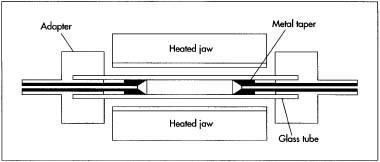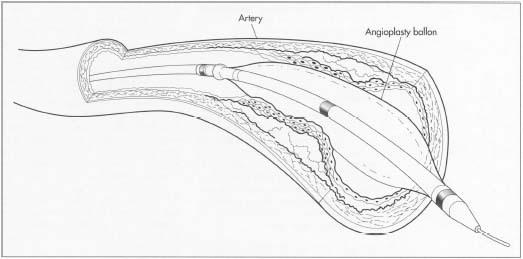Angioplasty Balloon
Background
An angioplasty balloon is a medical device that is inserted into a clogged artery and inflated to clear blockage and allow blood to flow. The full medical name for the angioplasty procedure is percutaneous transluminal coronary angioplasty. With extensive use in the United States since 1980, it can relieve angina (chest pain) and prevent heart attacks in people with coronary artery disease. Before angioplasty, bypass surgery was the only option for people with clogged arteries. In bypass surgery, doctors must open the patient's chest to reroute blood vessels to the heart. Angioplasty is less invasive, as the balloon is fed in through the blood vessels, and the chest remains closed. Patient recovery time is also generally faster with angioplasty, than with bypass surgery.
Angioplasty is performed under local anaesthetic, and the patient is kept awake so the doctor can ask if he or she feels any pain during the procedure. The surgeon opens the femoral artery at the top of the leg, and passes a catheter threaded on a thin guidewire into the blood vessel. The catheter, which is a tubular medical device, is about 3 ft (91 cm) long. The surgeon feeds the catheter through the blood vessels into the coronary artery. The catheter releases dye, so its precise position can be seen on a fluoroscope, which is an instrument used for observing the internal structure by means of x ray. When the first catheter is in place at the clogged artery, the surgeon feeds a smaller, balloon-tipped catheter through it. This catheter is about the width of a pencil lead, and the length of the balloon itself corresponds to the length of the affected section of artery—usually less than an inch. The surgeon guides the balloon-tipped catheter into the narrowed artery. The doctor inflates the balloon for a few seconds. It reaches a diameter of about an eighth of an inch (0.3 cm). If the patient does not feel any pain, then the doctor proceeds to inflate the balloon for a full minute. This clears the arterial blockage, and then the catheters are removed. The patient is treated with prescription drugs to thin the blood and prevent clots, and should recover from the operation within weeks.
In the late 1990s, about 500,000 people a year underwent angioplasty. Medical researchers continued to compare the benefits of angioplasty versus bypass surgery. The principal drawback of angioplasty is that up to half of all patients who undergo the procedure eventually require a repeat procedure. However, new methods are being conducted that prevent some of the scar tissue build-up that can narrow arteries after the procedure.
History
A German physician, Werner Forssmann, was the first known doctor to enter the heart with a catheter. He performed this operation on himself in 1929, when he was 25 years old. Forssmann worked at a small clinic in the town of Eberswald. He was interested in researching a catheter for the heart, but his superior at the clinic forbade him to investigate anything so dangerous. Undeterred, he decided to experiment without his superior's consent. But he did not have access to sterile instruments without the permission of a nurse. Forssmann persuaded a nurse to get him the instruments, convincing her he would use the catheter on her. The pliant woman agreed to let him operate on her. But

An Oregon doctor, Charles Dotter, investigated the dilation of narrowed arteries by means of catheters in the 1960s. Dotter opened narrowed leg arteries by passing progressively larger catheters through them. Dotter's work was taken up in Europe, though it received little attention in the United States. A balloon catheter for opening the iliac artery (at the top of the leg) was developed in 1973 by a Dr. Porstmann. Dr. Andreas Gruentzig, working at the University Hospital of Zurich in Switzerland, is credited with performing the first balloon angioplasty to open a clogged coronary artery. Gruentzig worked throughout the 1970s perfecting a balloon catheter that was thin and flexible enough to do the job. In 1977, he performed his first procedure. The patient suffered angina due to a single blocked artery. Gruentzig performed the operation with a team of doctors standing by to do an emergency bypass if the operation failed. But the angioplasty was successful. Gruentzig taught the technique to others, and brought his technology to the United States when he emigrated to Atlanta, Georgia, in 1980. Gruentzig died in a plane crash in 1985, but within 10 years of his introduction of angioplasty, the procedure was being performed on over 200,000 patients annually. That number rose over the next decade as the technique was refined, and better prescription drugs were found to prevent scarring after the dilation.
Raw Materials
The key requirements of angioplasty balloons are strength and flexibility. A variety of plastics has been used that combine these traits. The first angioplasty balloons in use in Gruentzig's time were made of flexible PVC (polyvinyl chloride). The next generation of balloon technology used a polymer known as cross-linked polyethylene. The materials typically used in the twenty-first century are polyethylene terephthalate (PET) or nylon. PET is the kind of plastic commonly used in plastic soda bottles. It is somewhat stronger than nylon, but nylon is more flexible. So either material is used, depending on the manufacturer's preference. Some angioplasty balloons are coated for lubrication, for abrasion resistance, or to deliver an anticoagulatory drug. In these cases, an additional raw material is required.
The Manufacturing Process
Angioplasty balloons are made by extruding material into a tube shape, and then forming the tube into a balloon through a process known as blow molding.
Extrusion
-
1 The raw materials for the balloon arrives at the manufacturing
facility in granulated
form. Workers empty the raw materials into a heated, barrel-shaped vat. As the granules melt and liquify, a rotating screw mixes the materials into a homogeneous blend. The liquid plastic is then pumped through an extrusion device. This is a nozzle with one hole cut in it. The liquid comes out the extruder as a long tube. The tube is pulled by a mechanical puller through a cooling bath, which freezes the tubing so that it is solidified. Next, a mechanical cutter chops the tubing to its specified length. At this point, the tubing is called a pre-form.
 An angioplasty balloon is inserted into a clogged artery and inflated to clear 6lockage and allow blood to flow.
An angioplasty balloon is inserted into a clogged artery and inflated to clear 6lockage and allow blood to flow.
Balloon forming
- 2 Next, the balloon is formed through blow molding. Though many tubes are cut, blow molding takes place one piece at a time. A worker inserts the pre-form into a device called a glassform. The manufacturer may have various glassforms that correspond to different finished diameters of the product. Next, one end of the tube is welded shut. The open end is connected to a supply of compressed air. Then two heated jaws close around the part.
- 3 The compressed air is switched on, and it keeps the pre-form at a constant inner pressure. The heated jaws warm the piece. This warmup time prepares the plastic for the next step. The blow molding process is controlled by a computer with sensors that determine when the material has reached the optimum temperature for the next step of pressure forming.
- 4 After the warmup, the computer signals the compressed air machine to switch to a high-pressure mode. The balloon is inflated at this high pressure for a specified amount of time. Shortly after the high-pressure stage begins, the heated jaws stretch the material. Then the formed balloon is cooled, again with compressed air. Now it is ready for removal from the glassform, inspection, and packaging.
Inspection
- 5 Angioplasty balloons go through a series of inspections for quality control purposes. Balloons are checked both by visual inspection and by machines.
Packaging
- 6 If the manufacturer makes only angioplasty balloons, and not the catheters that go with the device, the balloons are individually boxed, the boxes are bagged, and then shipped to a larger manufacturer. This manufacturer then assembles an angioplasty kit by wrapping the balloon around a catheter and sterilizing it. First, the balloon is collapsed by a vacuum pump. Then a worker glues or heat bonds it to a catheter shaft. The balloon is tested again at this point. Then the worker deflates the balloon again, wraps it around the shaft, places a protective wrapping over it, and sends it to be sterilized, making it ready for hospital use.
Quality Control
Quality control is, of course, extremely important in medical devices. Angioplasty balloons are manufactured one at a time, and typically each piece is inspected once it is formed. A worker inspects the balloon visually for any marked flaws. Then the worker loads the balloon into a machine that tests its wall thickness. Next, the balloon is placed in another machine, which inflates it and checks the internal pressure.
The Food and Drug Administration (FDA) oversees quality control for the medical device industry. A federal study in 1970 revealed thousands of injuries and a significant number of deaths related to medical devices. As a result, in 1976 Congress amended the Food and Drug act to give the FDA authority over medical device manufacturing. The FDA is required to be notified of every medical device before it can be marketed, and manufacturers must prove the device is safe and effective. Because of the importance of quality in angioplasty balloon manufacturing, the companies that make them are generally not aiming for economy of scale, or making a lot of balloons as fast as they can. Instead, the balloons are made in a labor-intensive fashion, one at a time, with step-by-step inspection.
The Future
Angioplasty is simpler and easier on the patient than bypass surgery, the procedure that it, to some extent, replaced. Its biggest drawback is that some 30-50% of patients undergoing the procedure need to repeat it because their arteries clog again. The initial clogging is known medically as stenosis, and when it happens after angioplasty, it is called restenosis. Most research into angio-plasty at the beginning of the twenty-first century concentrates on ways of preventing restenosis. Some angioplasty balloons are coated with prescription drugs, such as heparin, to prevent arterial buildup. Such a drug is routinely given to patients after the procedure, but with coated balloons, the drug can be delivered directly to the affected artery. Some surgeons are also experimenting with a device called a stent, which can be placed in the artery during angioplasty to prevent the vessel clogging again. Stents are small metal tubes that may be either stainless steel or some kind of flexible steel mesh. The newest angioplasty technology is involved with combining the balloon with the stent for the best results for both the patient and the surgeon.
Where to Learn More
Books
Friedman, Steven G. A History of Vascular Surgery. Mt. Kisco, NY: Future Publishing, 1989.
Fries, Richard C. Reliable Design of Medical Devices. New York: Marecel Dekker, Inc., 1997.
Klaidman, Stephen. Saving the Heart: the Battle to Conquer Coronary Disease. Oxford: Oxford University Press, 2000.
Periodicals
Sauerteig, Knut, and Michael Giese. "The Effect of Extrusion and Blow Molding Parameters on Angioplasty Balloon Production." Medical Plastics and Biomaterials Magazine (May 1998).
Stone, John. "Balloon Man." New York Times Magazine (October 16, 1988): 61.
— Angela Woodward
Comment about this article, ask questions, or add new information about this topic: